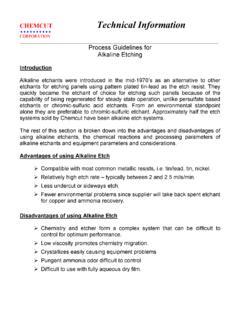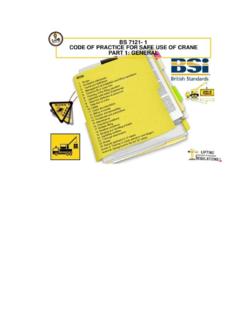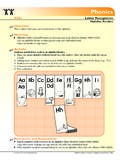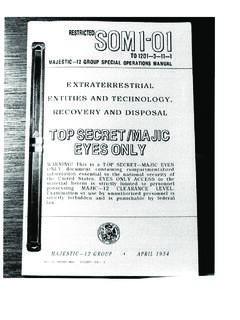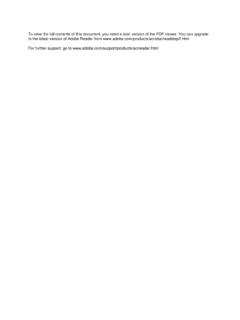Transcription of Etching Titanium with HF and Nitric Acid Solutions …
1 Etching Titanium with HF and Nitric acid Solutions part 1 Randy Markle Chemcut Chemcut has been building hydrofluoric acid Etching equipment since the 1960 s. HF was first used by the glass industry to produce a non- glare surface on television tubes. It has now become a viable chemical for the processing of silicon, in the solar industry, and Titanium and memory metals in the medical industry.
2 Our experience has shown that HF is seldom used by itself. It is usually combined with another chemical to produce an Etching or surface treatment solution. The mixture of HF and Nitric acid is becoming quite prevalent. Chemcut decided to study the effects of Etching Titanium using this solution. Hydrofluoric acid (HF) is the primary chemical needed to etch Titanium .
3 The Etching reaction is shown as: Ti + 3HF TiF3 + 3/2H2 1 Where the Etching of Titanium , with HF, produces Titanium trifluoride and hydrogen gas. Although HF, by itself, will etch Titanium , there are some disadvantages to using HF alone. First, there is the formation of hydrogen gas that is flammable and explosive. This can create a potential fire hazard. Secondly, the HF tends to dissipate quickly, requiring regular chemistry additions.
4 Thirdly, the etch rate is relatively slow. And lastly, the resulting surface finish may be undesirable. To offset some of these disadvantages, Nitric acid is added to the HF solution. This reaction is shown as: Ti + 6HF + 4 HNO3 H2 TiF6 + 4NO2 + 4H201 Here the Etching of Titanium produces hexafluorotitanic acid , nitrogen dioxide, and water. with this solution, the HF tends to be more stable, the hydrogen gas is eliminated, and the etch rate increases.
5 The purpose of this evaluation was to record the effects of different chemical concentrations on the etch rate and surface finishes when Etching Titanium with a hydrofluoric acid / Nitric acid solution. Undercut was not evaluated at this time, because the dry film used was not compatible with the HF. It allowed the fluoride ions to penetrate the resist and which caused loss of adhesion.
6 Undercut may be evaluated at a later date. The material used for the testing was grade 2, commercially pure Titanium , ( ) and ( ) in thickness. It was purchased with a mill finish. The constituents are; Titanium min, carbon max, oxygen max, nitrogen max, iron max, and hydrogen max. Its density is lb/in3, its hardness is Rockwell B68 to B80, and its yield strength is 40,000psi min.
7 The Titanium was prepared for Etching in the following manner. The Titanium was sheared into 6 x 6 sheets. The sheets were then degreased, by hand, with a solvent, and soaked in a phosphoric acid based cleaner for two minutes. They were then rinsed and dried. The thickness of each sheet was measured in four places, with a micrometer, averaged and recorded.
8 One side of each sheet was then masked from the Etching solution. Two sheets were etched under each set of chemical concentrations. The masking was then removed, and the resulting thickness measured, in four locations, and averaged. The amount of removed material was then divided by the etch time to give an etch rate in microns or mils per minute. The Etching Solutions were prepared with hydrofluoric acid (49%, ), Nitric acid (68%, ), and water, by weight percent.
9 Additions were made during the testing to adjust and maintain acid concentrations. The Etching was done in a Chemcut model 2315. The etch chamber has four spray tubes, top and bottom, running parallel to the direction of travel. The spray tubes also oscillate perpendicular to the direction of travel. Each spray tube contains four, 80 full cone nozzles rated at l/min ( gal/min) at bar (40psi).
10 The panels were etched using the top spray only at a pressure of bar (30psi). The oscillation rate was 30 sweeps per minute and the Etching temperature was C (110 F). The effective length of the Etching chamber is 21 ( ). Following is a small chart showing the HF and Nitric acid concentrations that were evaluated. HF HNO3 3% 0%, 3%, 6%, 10%, 15% 20% 5% 0%, 3%, 6%, 10%, 15%, 20% 10% 0%, 3%, 6%, 10%, 15%, 20% This chart shows the average thickness before Etching , the average thickness after Etching , the average thickness (material) loss, and the calculated etch rate for the 3% HF Solutions .
